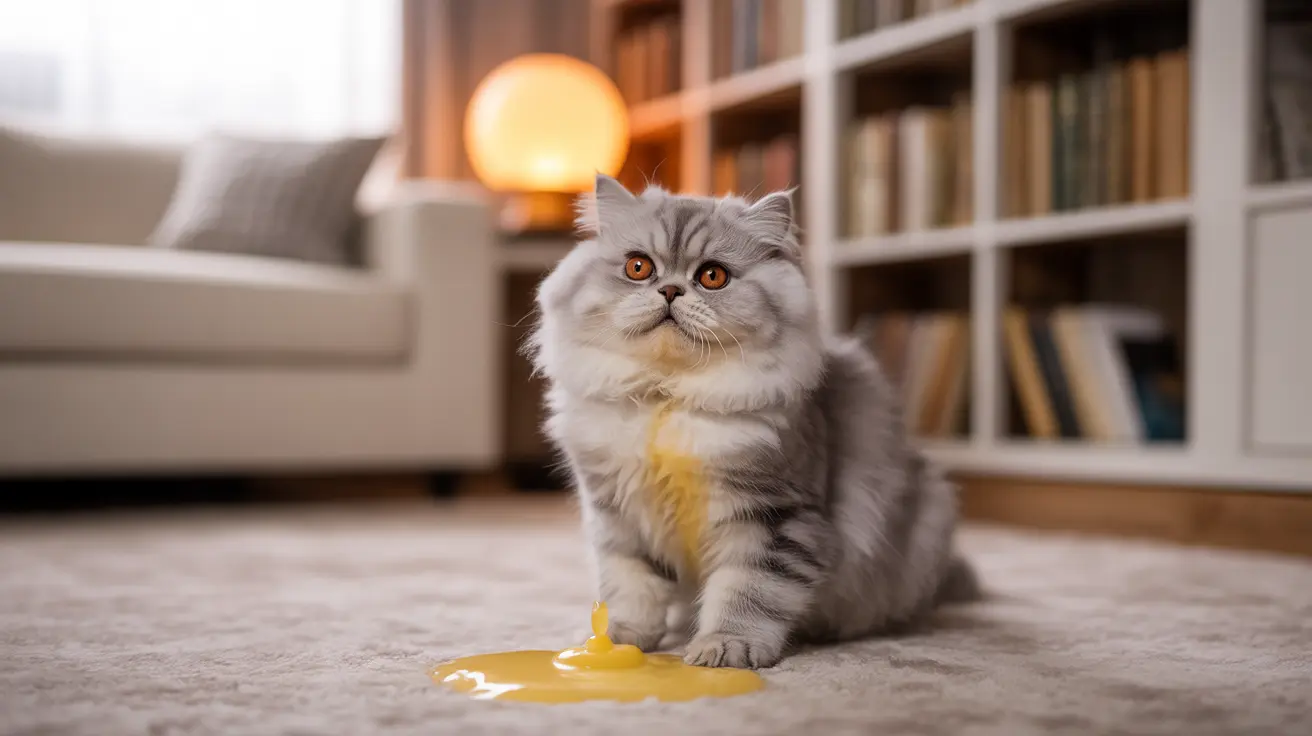Understanding Yellow Vomit in Cats
When your cat starts vomiting yellow liquid and refusing food, it's natural to feel concerned. This common but concerning symptom typically indicates the presence of bile in your cat's vomit, which can signal various underlying health issues ranging from minor dietary problems to serious medical conditions.
Bile is a digestive fluid produced by the liver and stored in the gallbladder. When cats vomit yellow liquid, especially on an empty stomach, it usually means bile has refluxed from the small intestine into the stomach, causing irritation and subsequent vomiting.
Common Causes of Yellow Vomiting and Loss of Appetite
Bilious Vomiting Syndrome
One of the most frequent causes of yellow vomiting in cats is bilious vomiting syndrome, which typically occurs when a cat's stomach remains empty for too long. This condition is especially common in the early morning or after extended periods without food.
Gastrointestinal Issues
Various digestive system problems can trigger yellow vomiting and appetite loss, including:
- Gastritis (stomach inflammation)
- Inflammatory bowel disease
- Food allergies or sensitivities
- Parasitic infections
- Foreign body obstruction
Serious Medical Conditions
More severe underlying conditions that may cause these symptoms include:
- Pancreatitis
- Liver disease
- Kidney disease
- Hyperthyroidism
- Certain types of cancer
When to Seek Veterinary Care
While occasional vomiting might not be serious, certain situations require immediate veterinary attention:
- Vomiting persists for more than 24 hours
- Complete loss of appetite for more than a day
- Signs of lethargy or depression
- Presence of blood in vomit
- Severe dehydration symptoms
- Concurrent diarrhea
Treatment and Prevention
Immediate Care Steps
If your cat begins vomiting yellow liquid:
- Temporarily withhold food for 4-6 hours
- Provide small amounts of water
- When reintroducing food, offer small, frequent meals
- Consider a bland diet temporarily
Long-term Prevention
To help prevent future episodes:
- Feed smaller meals more frequently throughout the day
- Maintain consistent feeding schedules
- Use elevated food bowls if recommended by your vet
- Address any underlying health conditions
- Regular veterinary check-ups
Frequently Asked Questions
Why is my cat vomiting yellow liquid but not eating?
This combination of symptoms often indicates bile reflux due to an empty stomach, but it can also signal more serious conditions like gastritis, pancreatitis, or systemic illness. If symptoms persist for more than 24 hours, veterinary attention is necessary.
What does it mean when a cat throws up yellow bile on an empty stomach?
Yellow bile vomiting on an empty stomach typically indicates bilious vomiting syndrome, where bile irritates the stomach lining due to prolonged periods without food. This commonly occurs in the early morning or after extended fasting periods.
Could hairballs cause my cat to vomit yellow liquid and refuse food?
Yes, hairballs can cause both vomiting and appetite loss. However, you would typically see hair in the vomit along with the yellow liquid. If no hair is present and symptoms persist, other causes should be investigated.
When should I take my cat to the vet if it keeps vomiting yellow liquid and won't eat?
Seek immediate veterinary care if vomiting continues for more than 24 hours, if your cat completely refuses food for more than a day, or if you notice additional symptoms like lethargy, diarrhea, or signs of pain.
How can I help prevent my cat from vomiting yellow bile and improve its appetite?
Prevention strategies include feeding smaller, more frequent meals throughout the day, maintaining regular feeding schedules, ensuring fresh water availability, and addressing any underlying health issues with your veterinarian.
Conclusion
While yellow vomit and loss of appetite in cats can be concerning, understanding the potential causes and knowing when to seek veterinary care is crucial. Many cases can be managed with appropriate dietary adjustments and medical intervention when necessary. Always consult with your veterinarian if symptoms persist or worsen, as early intervention often leads to better outcomes.






